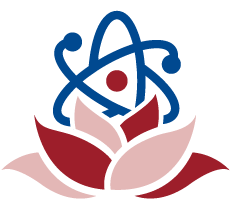| chromatid ཡ་རྐང་། (ཚོས་རྩིད།) | biol. Either of the two strands formed when a chromosome duplicates itself during cell division. The chromatids are joined together by a single centromere and later separate to become individual chromosomes. | ཕྲ་ཕུང་འབྱེད་རིམ་གྱི་ནང་དུ་ཚོས་གཟུགས་ངོ་འདྲ་བཟོ་བའི་སྐབས་སུ་གྲུབ་པའི་ཉག་མ་གཉིས་ལས་གང་རུང་ཞིག་ལ་ཟེར།ཡ་རྐང་རྣམས་དཀྱིལ་ཆ་གཅིག་ཁོ་ནས་མཉམ་དུ་མཐུད་སྦྲེལ་བྱས་ཡོད་པ་དང་རིམ་གྱིས་ཁ་འཕྲལ་ཏེ་ཚོས་གཟུགས་སོ་སོར་འགྱུར་གྱི་ཡོད། |
| chromatic aberration མདོག་འཁྲུགས། | phys. Distortion of an image caused when light of different colors (and thus different speeds and refractions) focuses at different points when passing through a lens. Achromatic lenses correct this defect by combining simple lenses made of different kinds of glass. | ཁ་དོག་སྣ་ཚོགས་ཡིན་པའི་འོད་(དེར་བརྟེན་མགྱོགས་ཚད་དང་འཁྱོག་ཚད་ཀྱང་སྣ་ཚོགས་པ་ཡིན་)དྭངས་ཤེལ་རྒྱུ་སྐབས་གནས་མི་འདྲ་བར་འདུ་བ་ལ་བརྟེན་ནས་གྲུབ་པའི་གཟུགས་བརྙན་གྱི་ཡོ་འཁྱོག ཤེལ་རིགས་སྣ་ཚོགས་ཀྱིས་གྲུབ་པའི་སྟབས་བདེའི་དྭངས་ཤེལ་ཟླ་སྒྲིལ་བ་ལས་གྲུབ་པའི་ཚོན་མདོག་གཡོ་སེལ་དྭངས་ཤེལ་གྱིས་སྐྱོན་འདི་སེལ་གྱི་ཡོད། |
| Chromaffin cell ཀོ་ཚྭའི་ཚོན་འབྱར་ཕྲ་ཕུང་། ཁོར་མེ་ཕིན་ཕྲ་ཕུང་། | neurosci. | [ཀོ་ལྕགས་ཀྱི་ཚྭའི་ཚོན་འབྱར་བའི་ཕྲ་ཕུང་།] |
| choroid plexus རྩ་སྐྱིའི་དྲ་རྒྱ། | biol. A network of blood vessels in each ventricle of the brain, producing the cerebrospinal fluid. | ཀླད་ཤག་རེ་རེའི་ནང་དུ་ཡོད་ཅིང་ཀླད་རྒྱུངས་གཤེར་ཁུ་སྐྱེད་སྐྲུན་བྱེད་མཁན་གྱི་ཁྲག་རྩའི་དྲ་རྒྱ་ཞིག |
| choroid རྩ་སྐྱི། | biol. A layer behind the retina of the vertebrate eye which contains blood vessels and pigment. | སྒལ་རུས་ཅན་གྱི་སྲོག་ཆགས་ཀྱི་མིག་གི་དྲ་སྐྱིའི་རྒྱབ་ངོས་སུ་ཡོད་པའི་ཆགས་རིམ་ཞིག་ལ་གོ་ཞིང་། དེའི་ནང་དུ་ཁྲག་གི་རྩ་སྦུབས་དང་ཚོན་རྩི་ཡོད་པ་ཡིན། |
| chorionic villous sampling (CVS) འགོ་ཆུ་ཕྱི་ཤུན་ཁད་སྤུ་སྤུས་འདེམ། | biol. Chorionic villus sampling (CVS) is a prenatal test in which a sample of chorionic villi is removed from the placenta for testing. The sample can be taken through the cervix (transcervical) or the abdominal wall (transabdominal). | བརྟག་དཔྱད་ཀྱི་ཆེད་དུ་ཤ་མ་ནས་འགོ་ཆུ་ཕྱི་ཤུན་ཁད་སྤུའི་དཔེ་ཚད་ཅིག་ཕྱིར་འདོན་པར་བྱེད་པའི་མ་བཙས་སྔོན་གྱི་བརྟག་དཔྱད་ཅིག་ཡིན། དཔེ་ཚད་དེ་ནི་མངལ་སྒོའམ་ལྟོ་བའི་ངོས་གང་རུང་ནས་བླངས་ཆོག |
| chorionic villi འགོ་ཆུ་ཕྱི་ཤུན་ཁད་སྤུ། | biol. Fingerlike growths that extend from extraembryonic membranes to implant into the uterine wall. | མངལ་གནས་ཀྱི་ཕྱི་ཤུན་ནས་ཐོན་ཏེ་བུ་སྣོད་ཀྱི་ངོས་སུ་འཛུལ་ཡོད་པའི་མཛུབ་མོ་ལྟ་བུའི་སྐྲངས་འབུར་ལ་ཟེར། |
| chorion འགོ་ཆུའི་ཕྱི་ཤུན། | biol. The outer membrane that encloses the embryo of a reptile, bird, or mammal. In mammals, the chorion contributes to the development of the placenta. | ལྟོ་འགྲོའི་སྲོག་ཆགས་དང་འདབ་ཆགས། ནུ་གསོའི་སྲོག་ཆགས་བཅས་ཀྱི་སྦྲུམ་སྲིང་བཏུམས་བྱེད་ཀྱི་ཕྱི་ཤུན་ལ་ཟེར། ནུ་གསོའི་སྲོག་ཆགས་ལ་མཚོན་ན། འགོ་ཆུའི་ཕྱི་ཤུན་གྱིས་ཤ་མའི་འཚར་འཕེལ་ལ་མཐུན་འགྱུར་བྱེད་ཀྱི་ཡོད། |
| Choreoathetosis དལ་མྱུར་རྩ་ནད། | neurosci. | [འགུལ་སྐྱོད་དལ་བའམ་མྱུར་མོ་ལྡན་པའི་རྩ་ནད་ཅིག] |
| chorea འཁྲབ་ནད། | biol. A movement disorder marked by involuntary spasmodic movements especially of the limbs and facial muscles and typically symptomatic of neurological dysfunction (as that associated with a neurodegenerative disease or metabolic disturbance). | གཙོ་བོ་རྐང་ལག་དང་། གདོང་པའི་ཤ་སྒྲིམ་ལ་གློ་བུར་དུ་རང་འགུལ་གྱི་འགུལ་བསྐྱོད་འབྱུང་བ་དང་ཁྱད་པར་དུ་ (དབང་རྩ་ཉམས་རྒུད་ཀྱི་ནད་དམ་ནུས་འགྱུར་འཁྲུག་སྐྱོན་དང་འབྲེལ་བ་ཡོད་པའི་) དབང་རྩའི་བྱེད་ལས་ཉམས་པའི་ནད་རྟགས་བཅས་ཀྱིས་མཚོན་པའི་འགུལ་བསྐྱོད་ཀྱི་འཁྲུག་སྐྱོན་ཞིག་ལ་ཟེར། |
| chordates སྒལ་ཐིག་ཅན། | biol. Any animal of the phylum Chordata, including the vertebrates and protochordates, characterized by a notochord, dorsal tubular nerve cord, and pharyngeal gill slits | སྒལ་ཐིག་ཅན་གྱི་སྡེའི་ཁོངས་སུ་གཏོགས་པའི་སྲོག་ཆགས་གང་རུང་རུང་ཞིག་སྟེ་སྒལ་རུས་ཅན་གྱི་སྲོག་ཆགས་དང་གདོད་མའི་སྒལ་ཐིག་ཅན་གྱི་སྲོག་ཆགས་གཉིས་ཀྱིས་གྲུབ། ཁྱད་ཆོས་སུ་སྒལ་ཐིག་དང་། སྦུག་དབྱིབས་ཀྱི་དབང་རྩ་རྒྱུས་ཐག གྲེ་བའི་མཚམས་སུ་ཉ་སྐྱོགས་ལྟ་བུའི་གཤགས་ཁ་བཅས་ཡོད། |
| Chordata སྒལ་ཐིག་ཅན་གྱི་སྡེ། | biol. A large phylum of animals that includes the vertebrates together with the sea squirts and lancelets. They are distinguished by the possession of a notochord at some stage during their development. | སྲོག་ཆགས་ཀྱི་སྡེ་ཆེན་པོ་ཞིག་གི་མིང་སྟེ། འདིའི་ཁོངས་སུ་སྒལ་རུས་ཅན་གྱི་སྲོག་ཆགས་དང་། མཚོ་གནས་ཆུ་མདའ་ཅན། མདུང་ཉ་བཅས་གཏོགས། ཁྱད་ཆོས་གཙོ་བོ་ནི་འཚར་འཕེལ་གྱི་གནས་བབ་ཅིག་གི་སྐབས་སུ་སྒལ་ཐིག་ཡོད་པ་དེ་ཡིན། |
| Cholinergic ༡) ཁོ་ལིན་སད་སློང། ༢) ཁོ་ལིན་ནུས་ལྡན། | neurosci. | [ཁོ་ལིན་གྱི་ནུས་པ་ལྡན་པའི་རྫས།] |
| choline ཁོ་ལིན། (ཟས་བཅུད།) | biol. An amino alcohol, found in cells, where it is involved in the metabolism of phospholipids, particularly those associated with the membranes of nerve cells. | ཕྲ་ཕུང་གི་ནང་དུ་ཡོད་པའི་ཨེ་མི་ནོ་ཆང་རྫས་ཤིག་ལ་གོ་ཞིང་། འོད་མའི་ལི་ཚིལ་གྱི་ནུས་འགྱུར་དང་ལྷག་པར་དུ་དབང་རྩ་ཕྲ་ཕུང་གི་སྐྱི་མོ་དང་འབྲེལ་བ་ཡོད་པའི་འོད་མའི་ལི་ཚིལ་གྱི་ནུས་འགྱུར་གྱི་ནང་དུ་ཐེ་གཏོགས་བྱེད་པ་ཡིན། |
| cholesterol མཁྲིས་ཞག། | biol. A fatty substance found in animals that is a main component of cell membranes and is important in metabolism and hormone production. In vertebrate animals, cholesterol is a major component of the blood. | ཕྲ་ཕུང་གི་སྐྱི་མོའི་གྲུབ་ཆ་གཙོ་བོ་ཞིག་ཡིན་ཞིང་སེམས་ཅན་གྱི་ལུས་པོའི་ནང་དུ་ཡོད་པའི་ཞག་རྫས་ཤིག་ལ་གོ་བ་དང་། འདི་ནི་ནུས་འགྱུར་དང་རྨེན་རྫས་ཐོན་སྐྱེད་གཉིས་ཀྱི་ནང་དུ་གལ་ཆེན་རེད། སྒལ་རུས་ཅན་གྱི་སྲོག་ཆགས་ཀྱི་ནང་དུ་མཁྲིས་ཞག་ནི་ཁྲག་གི་གྲུབ་ཆ་གཙོ་བོ་ཞིག་ཡིན། |
